A few weeks ago I posted a link to a very smart post about pointcrawls from Anne at DIY & Dragons.
As Anne explained in her first post on the matter:
At its most basic, pointcrawling is a way of depicting space that maps a set of known locations as “nodes” that are connected by a limited number of “paths.” Depending on a judge’s time and artistic talent, this diagram could consist of little more than numbered circles connected by straight lines (something similar to the early Scorpion Swamp pointcrawl introduced in the Fighting Fantasy books, seen in Figure 1 below.)
Alternatively, it could be much more detailed, either an artistic rendering or an information-encoding scheme to visually depict the location at each “node,” and likewise some method of giving more information about each “path.” In Figures 2 and 3 below, Hill Cantons shows a scheme for color-coding and labeling square nodes to show information about each location at a glance, while using different kinds of lines to instantly communicate information about the types of paths. (Really, his whole series of articles on this is an excellent read.)
The post goes into a lot more detail. But I think the value of pointcrawls might not be immediately obvious because we are trained to expect full terrain maps and full deck plans.
But the fact is, a full deck plan of a starship might not be required for an evening of play for Traveller. Consider this: a pointcrawl could be made of a starship, showing all the chambers on board and the routes might be able to take from one chamber to another. There’s really no need to draw up full deck plans. And if one is focused on a “theater of the mind” presentation of the ship and onboard action to the Player rather than miniatures, a pointcrawl might actually make a lot more sense. One need only glance down at the nodes and connections to see where the Player Character is in relation to other elements of the ship. Notes can be marked up next to the nodes (or within them) or however you want to roll.
The point being that sometimes we get so caught up in “the way things are supposed to be done” we don’t think through, “What exactly is the most useful way to record and impart this information?” or “What do I really need to run the encounter on this starship?”
Here’s the pointcrawl of a 200 ton Type A Free Trader I just whipped up for this post.
Notice that it tells me almost anything I’m going to need to describe what is happening on a ship. Most rooms are not going to be more than 8 meters across, which means that most combats will be at Close or Short range and sometimes stretch to Medium if the combats really make sure they’re firing at each other from one end of a longer room to another. Notice that cargo hold, even from end to end, falls within Medium range. (Notice too, that at certain points, where I thought it might matter, I noted the length or dimension of a room or corridor. One could do that with every room if one wanted to.
Now, listen. We all have access to the deck plans of a 200 ton Free Trader. This illustration isn’t that big a deal, in part because we all have those plans and in part because the lower deck of a Free Trader isn’t really that complicated or big.
But let’s say you needed to whip up a Corsair or any other kind of ship. The question is how much work do you really need to put into whipping up a new ship? Do you really need detailed deck plans to scale? Will your players ever notice if you don’t?
But let’s think about bigger locations:
- space stations
- underground mining operations
- cities of a billion people
- the continent of an alien world
- and so on…
Do you really need a details map of all the locations?
My guess is no, you really don’t. You do need to know major locations. You do need to know how one place connects to another. (Is there a monorail between the two locations? Or do you have to walk? Use different colors for each type of movement and name travel times and your pointcrawl becomes both useful and efficient!) Entire continents can be mapped out this way, with key points of interested written down as nodes and notes about traversing the distances between the nodes right on the sheet. (Here’s a link to a post at Hill Cantons about replacing wilderness hex-maps with wilderness pointcrawls. Really worth checking out!)
Traveller is a tricky game in that the Player Characters can (and should) travel from world to world to world. This is, I think, one of the reasons the game can seem daunting to Referees (or would be Referees). If you’ve been raised on RPGs thinking you need full color maps of cities and continents draw to scale, the thought of having to create, say, 20 planets, along with all the cities, colonies, bases, and ancient ruins might seem overwhelming. And let’s be clear–IT IS OVERWHELMING!!! A given subector might have 20 planets. The idea that you, as the Referee will have all the details of those worlds mapped out and ready to go because the Players decide to have their characters pick up stakes and light out for another planet on a whim would drive anyone mad. This is supposed to be a fun hobby… not a full time job!
And keep in mind: When I write all of this, I am assuming that the original Traveller rules were designed for improvised play… not railroaded plots. The Player Characters should be able to pick up stakes and head off to a new world on a whim, and new troubles should arrive on a whim as well. That’s what the game is about.
Also keep in mind that the abstract range band system from the original Traveller rules. Marc Miller provided a solid, abstract system that could keep things moving along without getting bogged down in measuring every foot minutia. “Mapping” as we know it from early Dungeons & Dragons makes sense if you are underground, in an ill-lit environment, wondering if you’ll remember how to get out, while checking the map for empty gaps that might suggest there is a secret door you passed and missed earlier. You don’t need that level of mapping detail if you’re hangout out on a space station or taking a monorail from one city to another. The notion of pointcrawls fits right into the design philosophy of the original Traveller rules.
So, is it worth it to you to relive yourself of the responsibility of having to map out entire continents and space stations in order to give your players plenty of freedom, cut down on your prep time, and give yourself the confined to know you can handle whipping up whatever environment your players go to?
Finally, Anne has promised to get to a post about “mini-crawls” very soon. But in the meantime she has a new post up with more examples of pointcrawling.

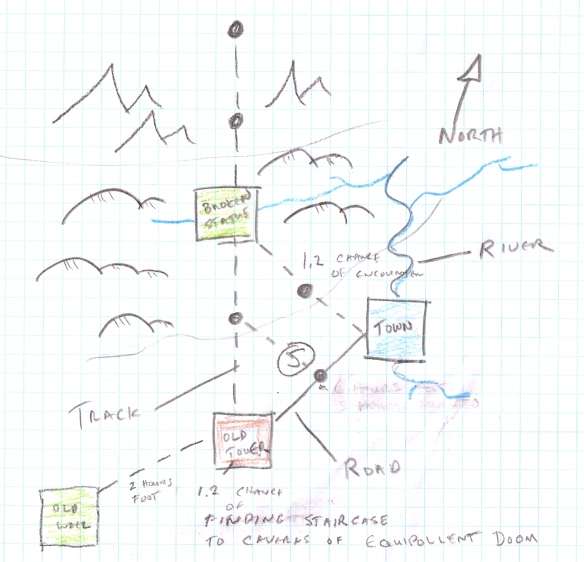
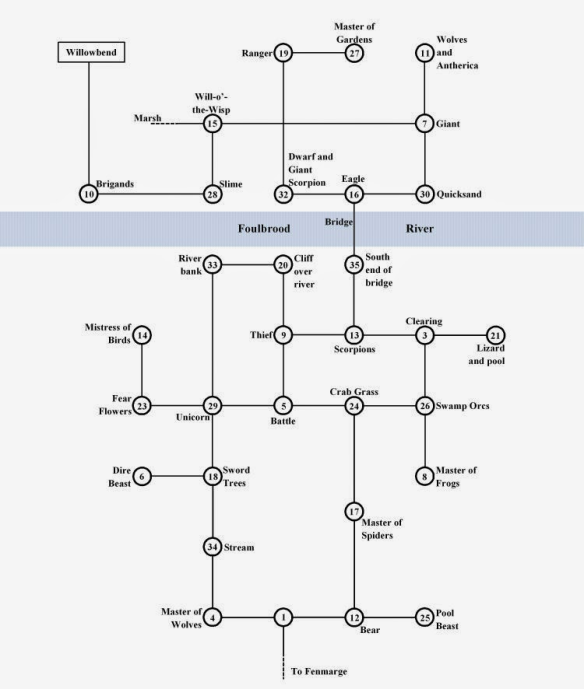
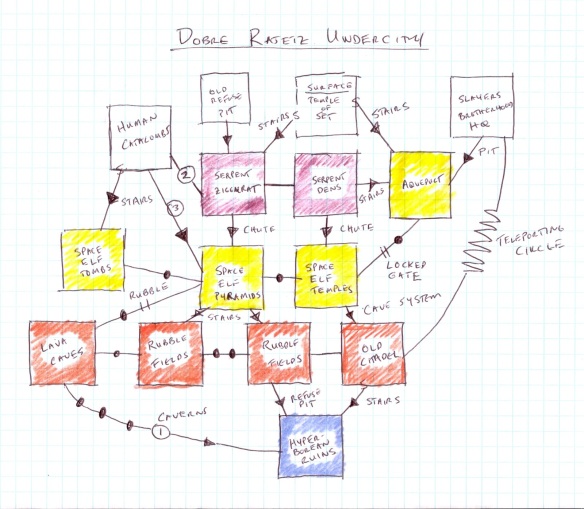
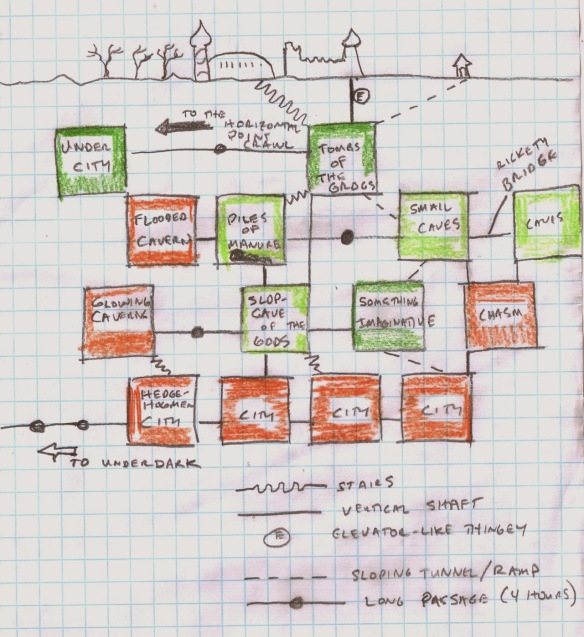
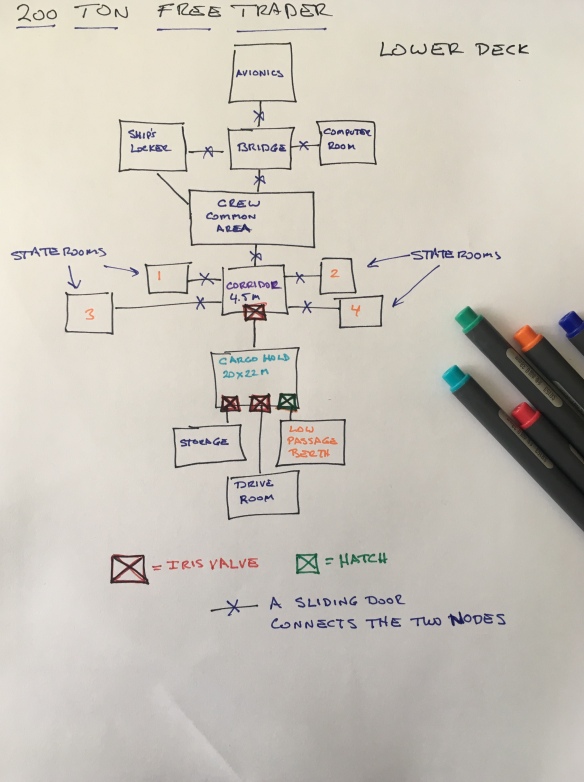
Good point. Most of my off the cuff maps (and I bet lots of other people’s) are like that. Never thought to do it for a starship. What a timesaver! And it reminds me of the node maps I used to make playing ‘adventure’ style computer games.
This is like DGP’s use of the “nugget” format.
Clever use of the idea for deckplans, though!
The late, great Clay Bush turned all the JTAS Amber Zones into nuggets, if you’re intetested…
http://members.tip.net.au/~davidjw/tavspecs/best_tml/Amber%20Zone%20-%20All%20JTAS%20Amber%20Zones%20in%20nugget%20format%20(JTAS%201%20to%2024).htm
While I can see how there are visual similarities between the pointcrawl diagrams and DGP’s Nugget format, I need to point out that they are not the same thing at all to avoid any possible confusion.
The Nugget format was one of several formats created for a publisher to write and nail down an RPG railroad. Even if there are “side tracks” available, the Nugget system depended on scenes that “have to” happen, and the scenarios are designed to force the Players/Player Characters along certain expected paths and toward certain climaxes.
While I appreciate many people do like this style of play, refereeing and RPG prep, it is not a style I like at all, and I’d never do anything to advocate such play.
(Note the links in the article above, where I lay out in several blog posts that Traveller was originally built (as were all RPGs of the start of the hobby) not to presume a pre-set “story” the PCs were to follow, but “situations” that the PCs would confront that would then spin out into more situations… with neither the Players or the Referee ultimately knowing where they were going. The notion of the railroaded story plot is the opposite of how I like to play RPGs.)
Instead, the pointcrawls are terrific notations for the Referee for handling and keeping track of where the PCs can go, how long it might take, what the options for movement are and so on… all without getting bogged down in creating the detailed maps that we a) all LOVE; and b) can be quite time consuming and create a prep to play ratio that some people might find onerous.
Pointcrawls used as a notion for geography don’t dictate any order of events, expectations for the night’s session, or any kind of story. The PCs might travel between two nodes back and forth all night, and the Referee has no expectation of any other nodes they should go to.
Instead, what I am advocating is in a game where the Player Characters can travel between worlds in a moment’s notice, or jump in an air raft and traverse a chunk of a continent, or arrive at a whole new city the Referee hadn’t prepped for at all, a system for setting up major points of interest and methods for tracking travel times and routes with nodes and lines makes a lot more sense then expecting the Referee to whip out a sheet of hex paper and craft an entire new planet or metropolis.
Even if used as a tool of pure exploration, the purpose of the pointcrawl is *not* to guide or steer the PCs along a certain path or set of encounters. It is to make the Referee’s job easier in terms of tracking geography in a more efficient method. It has nothing to do with forcing the PCs along certain paths or toward certain scenes or encounters the Referee can’t wait for the PCs to reach.
With all that said, I wanted to see Bush’s Amber Zone/Nugget work. However, the link does not seem to work. I tracked the page down and here is a shorter version of the link that I think might work better:
https://bit.ly/2E2fpYz
While I appreciate the that details of the situations are more clear laid out than the presentation in JTAS, again, I never assume I know what the PCs are going to end up doing, caring about, or driving for by the time the game is underway. But I appreciate the method does work for many people.
Two things.
1) In defence of the nugget format, which I quite liked, it is a tool just like so many others – so it didn’t always get used quite the way it was intended. I used it to help come up with a structure that became a guide for running scenarios. It was a long time ago now – but I remember clearly that with the people I game with, getting them to follow a plot line is like herding cats. Letting them, if they discover & choose to follow, is fine. I tried it when this first became popular, and for me and my friends it mostly didn’t work. But I found using the DGP nugget style helped me be better prepared. I just learned to be prepared for the scenes that ‘must happen’ not happening, and if things were a bit too rigid, I adapted them prior to play. IE I avoided the railroading behaviour (mostly) that they encouraged. I’m not sure anything ever played out as originally conceived and written, whether it was purchased or home grown. But the planning always helped. Mainly to warm up my mind, I think.
So are there any special things you do for coping with the PCs being able to go anywhere? Other than using the rather excellent inspirations in the CT tables? Do you pre-roll a few patrons or NPCs, for example? I’m curious because I’m finding it harder to ‘wing it’ these days.
Can you tell me what you think I mean by improvised? Because what I mean and what you mean might be two different things.
I gave an example of improvised play here:
I provided the players with a situation: a map to a valuable relic on a world caught up in conflict; and pirates on the trail of the PCs.
I had no idea what would happen after I handed off the situation. No path. No climax planned. Note that the pirates NEVER SHOWED UP.
I had no idea the Players would get themselves hired as part of the local militia and so on.
I didn’t go in with nothing. I went in with a situation, conflicts (some directed at the PCs (pirates), some not (the local war), a possible goal, and the awareness the Players might well make up THEIR OWN GOAL that I could not possibly anticipate. With these pieces in place I began, creating new PCs, locations, and situations on the fly.
Note that creating characters in Traveller is a snap. Six characteristics, maybe a skill or three, and your done. I don’t think there is any RPG where stat-blocking and creating characters is easier. Which is one of the reasons why I feel so comfortable creating adventures on the fly — the game was built to do this.
I’ve given the point-crawl format a try with an adventure location I’m working on for an upcoming game. It looks good, and goes so much faster than graph paper and rulers. But I still like graph paper & rulers. I may not use them for everything, though. If my player’s group get a ship, it deserves proper deck plans b/c they will use it all the time. But a once-and-done location can be sketched in minutes with this method. Thanks, Chris.
I’d be interested to hear more about how the pointcrawl works in actual play. My question is how does the referee communicate the options to the players? In some circumstances it might make sense to share an edited version of the pointcrawl, e.g. a list of points of interest in a city or district. Other times that might not work so well. Grateful if someone could point to some actual play examples, or share other thoughts on how it could work.
I haven’t done a point crawl, but for a city, I would expect one way to navigate is to get directions from an NPC. You might be able to get optional directions so as to navigate the different routes. Over time, the players will build up a knowledge of the city and it’s connections.
For wilderness, you would be presented with options: follow the road, follow an old game trail, work your way along the river (or take a river boat of some sort), etc. Look at non-hex wilderness maps, how would you navigate them?
Wilderness point crawls superimposed on a non-hex map like the example at the top of the post work really well. Here’s a board game point crawl that came immediately to mind when thinking of this:
https://boardgamegeek.com/image/306339/search-emperors-treasure
Actually, looking at that again, it’s a really good example. The one thing that it doesn’t show that could be valid is a route on the river at the bottom of the map, but it does show how a point crawl could work for sea travel.
Following up on Frank’s points:
to the Players. The Referee (in the first stage, I suppose we might call it) simply describes to the players what is before them. There’s a long, studied history of this kind of play in RPGs. A second option would be to have a second sketch, a rough one, on a sheet of paper, set out on the table, that the Referee keeps building as more information is recorded and the Players want firmer data.
The third option is for the Players to take notes and build their own diagrams and maps as they decide things are important to keep track of. Again, this is how RPGs have worked for decades.
Here’s the thing: If people (the Referee, the Players) really *want* a detailed map, one can be made/found/provided. I’m not arguing against having a fancy deck plan for the Player’s Ship. I am saying that thinking one has to have a detailed map of *every* location that might show up in a Traveller game not only is daunting but might well waste a lot of time.
I also know (because its a hot topic in RPG circles these days) that in lots of groups the Referee simply places maps in front of Players a lot of the time. (This seems to be especially a part of hangout /Roll20 play.) I understand why people might do this — but I am specifically talking of a kind of play where the Referee describes and the players take notes and make maps on their own as they see fit.
Also, I understand maps will certainly be helpful in certain tightly tactical situations. I also believe some groups will be find with more “Theater of the Mind” play without needing detailed, gridded maps.
Interesting observations. I’m going to have to try a pointcrawl.
Thanks for the reference example on improvised play. I think my idea of improvised is quite similar to yours. Perhaps not as precisely formulated. I’m just not as practiced either I think.
Thinking about the pointcrawl stuff, I realise I generally run cities as a point or zone crawl. Not streetplans, or grid/hex movement. Just zones to move through from source to destination, with encounter rolls based on situation. Detailed maps aren’t actually that detailed, mostly enough for some tactical considerations to come to bear, cover & obstacles to be identified, and then semi-theatre of the mind like. World’s or the starport are the same. Just never thought to really do the same for a starship. Which, in hindsight, is perfectly reasonable.
I used to do these for non-dungeon D&D games and called them Contingency Trees. I like this article a lot — bit more developed than what I did. Thanks for reminding me of this. Will use it in my next Traveller game.
Pingback: Interwebs Treasures #20 – Concrete Lunch Gaming
I’d like to describe how I always implemented ‘nugget’ style adventures:
The PCs are a group that has multiple brains, often ready to run in varied directions, and they ought (in my opinion) to have agency as to the direction they go *most of the time*.[1]
NPCs are either neutral, allies or foes and sometimes they execute different roles at different times in the game. In this category, I include important individuals and factions (which behave similarly).
Players sometimes want to lead and have a course of their own (which is great) based on what they know of the universe. Sometimes they enjoy being drawn into a situation unfolding – either between NPCs/factions or simply by their presence in a particular locale.
In real life, a human has some control of their direction and some things forced up on them by fate. I use that as a bit of a model in running my games.
For me, a nugget is either an actor (individual or faction) or an event: (each on a file card)
An important individual – who they are, what their goals are, what their assets are, what style of approach they tend to use, and any other key facts (achilles heels, things they love or hate, history, etc)
A faction – what the faction is, what its goal or goals are, what their assets are, what style of approach they tend to use, and any other key facts
An event – which combines an actor with a goal trying to carry out a plan and that plan often has a location (could be multiple actors present)
From a map, a handful of events going on and a bigger handful of important people and factions, a series of possible intersections between actors and players, players and locations where actors may be nearby, or between actors and other actors where players might see or encounter… you end up with the strike points where adventure occurs.
About 1/3rd of the time, some sort of event will kick off a session. After that , sometimes the actors responsible may drive their agenda forward in a way that players are pressed or even cornered, but often there are ways out or ways to turn the tables. About 2/3rds of the time, players choose to involve themselves in an event (or events) and thus come to the attention of actors. Sometimes it is a conscious and planned intervention (player-driven) and sometimes it is the result of being where something was happening (player response to stimuli).
So most of the time, the players have agency in their fate – if they choose to involve themselves, that’s one way (well two – intentional/planned or reactive to circumstances) and if they are dragged into some actor’s machinations, they can often find ways to take initiative and own the situation’s flow.
I see this as fairly close to complete sandbox adventuring because the actors are part of the sandbox and the agency is likely 80% player driven in one way or another. (This is part of how Apocalypse World works)
Now, to point-crawls. I’m very with you for dungeons and alien complexes and so on. Great tool. For ship deck plans, maybe less so.
In our experience, the reality of deck plans and miniatures/tokens means there is much less confusion for tactical actions. Theater of the mind is great, but everyone has their own mind and those heterogeneous views of what is happening can lead to player and GM frustration. Once everyone can see where a player’s representation stands, and everyone knows that if that representation needs to go somewhere, the representation needs to move there… confusion is much minimized.
Beyond that, there are relationships that are very visual. If you look at MegaTraveller’s Starship Operator’s Manual, the depictions of the inside of the Type A give a texture and a design aesthetic in a way that even gifted narrators would have hard time eliciting. A picture really can be worth 1000 words and again (as with the tactical situation) it can breed a common understanding of some aesthetics, geometries and situations.
So for something as frequently used as the group’s ship… yeah, I’d stick to deck plans. And deck plans are available for so many games now… hundreds of them. So I still prefer having that visual reference as do my players. (and a painted PC figure really can capture and help crystalize how a player thinks about his PC as well…).
Lastly, re: railroad vs. sandbox. If you are listing all of the places of major interest, you are, in a sense, creating a multiple choice railroad. You have already decided what is of interest.
If you went full improv a la Apocalypse World, they’d say don’t do much more than your immediate area (and that only vaguely) and discover the rests at the table. So you couldn’t even pen in the most interesting places because both you and the players would make contributions that would define them at the table. So point crawls (which I love) and nuggets on file cards both are some degree of pre-defining a universe, but the players can still have a LOT of agency and the GM can manage many situations without formal maps, etc. even if a few pre-defined aspects go.
In some cases, players want to explore an environment created by a GM so they can tourist around it and learn about it. In some cases, players want to build that world from the aether themselves. A lot depends on knowing how much your players want to tourist and how much they want to world build. Usually, for any given group, on any given week, some percentage of each works well… either extreme being rarely seen (from the groups I’ve played with).
Great site, by the way.
Thank you for the compliment.
And thank you for the thoughtful post!
It occurs to me another advantage (following from something I said in my first post) for point crawls is this:
If you go heavily improv / discovery at time of utterance (a la Apocalypse World or something like that), a regional point crawl map can quickly be created at the table as a collaborative effort by the players and GM. *THAT* you can’t as easily do with a full dungeon map on graph paper… there’s more labour to get that right than the point crawl, so for rapid creation, the point crawl has a distinct value add.
Beyond that, you can look at the pointcrawl as a creation tool and if the dungeon was one to be revisited (or the ship), you could use the point crawl to inform the creation of the actual dungeon map or deck plans. So both formal maps and informal point crawls can co-exist in the same setting. If I ever have to off-the-cuff a dungeon or other sort of activity that comes from a random encounter or a strange player choice, I realize I inevitably use either a textual or visual pointcrawl style to quickly whack down notes that align with what I narrate so that I can flesh it out more if necessary before the next gaming session.
The comic Knights of the Dinner Table has a storyline about players wanting to do their own thing / not follow the railroad / misunderstanding the things the GM was dangling in front of them (EVERYTHING matters… or maybe it doesn’t). The gist of it is they are enroute to the planned dungeon, want to go off into the woods, the GM tries to thwart them, and they get the impression there is something magical about these woods that are forcing them back to the path and are magically not letting them pass to other locations and later on the party does go off the path a bit and the GM is narrating and describes a gazebo. None of the players know what that is (here’s where visuals would have helped) and they end up engaging the ‘dread gazebo’ and the from this I think someone actually wrote up stats for an animated gazebo….
…all that to say that players will have minds of their own, will see as key details things you just ‘threw in there for colour’ and will totally miss what you thought was an obvious path/decision/bit of info and thus FUBAR the railroad. They’ll also intentionally resist a railroad if they see it (my headstrong lot anyway). So sandboxing and pointcrawls can let you manage player groups who lean more towards ‘we do our own thing’ than ‘here’s the 3 act play of the evening’.
Agreed. And since I specifically advocate for playing original TRAVELLER with a more improvised, rather than story-scripted style-this is one of the reasons I suggest using the techniques described above.
When you have carefully built, fully detailed maps as a Referee, it is easy to get stuck into thinking the players are *supposed* to go to that location. Lighter prep maps take some of the sting off the players not going to a particular location. And it is, as you say, easier to whip up a pointcrawl map as needed when the PCs go off and do something unexpected.